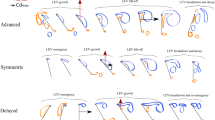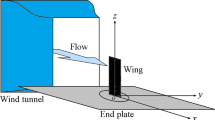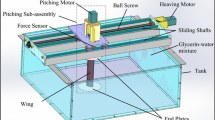Abstract
We conducted a systematic experimental study to investigate the aerodynamic effects of active trailing-edge flexion on a high-aspect-ratio wing translating from rest at a high angle of attack. We varied the timing and speed of the trailing-edge flexion and measured the resulting aerodynamic effects using a combination of direct force measurements and two-dimensional PIV flow measurements. The results indicated that the force and flow characteristics depend strongly on the timing of flexion, but relatively weakly on its speed. This is because the force and vortical flow structure are more sensitive to the timing of flexion relative to the shedding of starting vortex and leading-edge vortex. When the trailing-edge flexion occurred slightly before the starting vortex was shed, the lift production was greatly improved with the instantaneous peak lift increased by 54 % and averaged lift increased by 21 % compared with the pre-flexed case where the trailing-edge flexed before wing translation. However, when the trailing-edge flexed during or slightly after the leading-edge vortex shedding, the lift was significantly reduced by the disturbed development of leading-edge vortex. The force measurement results also imply that the trailing-edge flexion prior to wing translation does not augment lift but increases drag, thus resulting in a lower lift–drag ratio as compared to the case of flat wing.













Similar content being viewed by others
References
Batchelor GK (1967) An introduction to fluid dynamics. Cambridge University Press, Cambridge
Bilgen O, Kochersberger KB, Inman DJ (2010) Novel, bidirectional, variable-camber airfoil via macro-fiber composite actuators. J Aircr 47(1):303–314
Birch JM, Dickinson MH (2001) Spanwise flow and the attachment of the leading-edge vortex on insect wings. Nature 412(6848):729–733
Chen K, Colonius T, Taira K (2010) The leading-edge vortex and quasi-steady vortex shedding on an accelerated plate. Phys Fluids 22:033601-1–033601-11
Cheng B, Sane SP, Barbera G, Troolin DR, Strand T, Deng X (2013) Three-dimensional flow visualization and vorticity dynamics in revolving wings. Exp Fluids 54(1):1–12
Cheng B, Roll J, Liu Y, Troolin DR, Deng X (2014) Three-dimensional vortex wake structure of flapping wings in hovering flight. J R Soc Interface 11(91):1742–5662
Deng X, Schenatp L, Wu WC, Sastry SS (2006) Flapping flight for biomimetic robotic insects: part I—system modeling. IEEE Trans Robot 22(4):776–788
Dickinson MH, Gotz KG (1993) Unsteady aerodynamics performance of model wings at low Reynolds numbers. J Exp Biol 174:56–64
Ennos AR (1987) The importance of torsion in the design of insect wings. J Exp Biol 140:137–160
Gupta V, Ippolito C (2012) Use of discretization approach in autonomous control of an active extrados/intrados camber morphing wing. AIAA paper 2603
Jeong JH, Hussain F (1995) On the identification of a vortex. J Fluid Mech 285:69–94
Johansson LC, Wolf M, Busse RV, Winter Y, Spedding GR, Hedenstrom A (2008) The near and far wake of Pallas’ long tongued bat. J Exp Biol 211:2909–2918
Liu Y, Cheng B, Barbera G, Troolin DR, Deng X (2013) Volumetric visualization of the near- and far-field wake in flapping wings. Bioinspir Biomim 8:036010-1–036010-8
Lua KB, Lim TT, Yeo KS (2008) Aerodynamics forces and flow fields of a two-dimensional hovering wing. Exp Fluids 45:1047–1065
Lua KB, Lim TT, Yeo KS (2011) Effect of wing-wake interaction on aerodynamic force generation on a 2D flapping wing. Exp Fluids 51:177–195
Ma K, Chirarattanon P, Fuller S, Wood RJ (2013) Controlled flight of a biologically inspired insect-scale robot. Science 340(6132):603–607
Norberg UM (1976) Aerodynamics, kinematics and energetic of horizontal flapping flight in the long-eared bat. J Exp Biol 65:179–212
Panah AE, Buchholz JHJ (2014) Parameter dependence of vortex interactions on a two-dimensional plunging plate. Exp Fluids 55(3):1–19
Perry ML, Mueller TJ (1987) Leading- and trailing-edge flaps on a low Reynolds number airfoil. J Aircr 24(9):653–659
Pitt-Ford CW, Babinsky H (2013) Lift and the leading edge vortex. J Fluid Mech 720:280–313
Pullin DI, Wang ZJ (2004) Unsteady forces on an accelerating plate and application to hovering insect flight. J Fluid Mech 509:1–21
Sane SP (2003) The aerodynamics of insect flight. J Exp Biol 206:4191–4208
Santhanakrishnan A, Pern NJ, Jacob JD (2005) Optimization and validation of a variable camber airfoil. AIAA paper 1956
Valasek J (2012) Morphing aerospace vehicles and structures. Wiley, Hoboken
Wagner H (1925) Über die Entstehung des dynamischen Auftriebes von Tragflügeln. Zeitschrift für angewandte Mathematik und Mechanik 5:17–35
Walker SM, Thomas ALR, Taylor GK (2010) Deformable wing kinematics in free-flying hoverflies. J R Soc Interface 7:131–142
Walker SM, Thomas ALR, Taylor GK (2012) Operation of the alula as an indicator of gear change in hoverflies. J R Soc Interface. 9:1194–1207
Wolf ML, Johansson LC, Busse RV, Winter Y, Hedenstrom A (2010) Kinematics of flight and the relationship to the vortex wake of a Pallas’ long tongued bat. J Exp Biol 213:2142–2153
Wu JC (1981) Theory for aerodynamic force and moment in viscous flow. AIAA J 19(4):432–441
Xia X, Mohseni K (2013) Lift evaluation of a 2D pitching flat plate. Phys Fluids 25:091901-1–091901-26
Yu X, Sun M (2009) A computational study of wing–wing and wing–body interaction of a model insect. Acta Mech Sin 25:421–431
Zhao L, Huang Q, Deng X, Sane SP (2010) Aerodynamics effects of flexibility in flapping wings. J R Soc Interface 7:485–497
Zhao L, Deng X, Sane SP (2011) Modulation of leading edge vorticity on the aerodynamic forces in flexible flapping wings. Bioinspir Biomim 6:036007-1–036007-7
Acknowledgments
This work was funded by Air Force Office of Scientific Research (AFSOR) Grant number FA9550-11-1-0058. SPS was funded by the Ramanujan fellowship from the Department of Science and Technology, Government of India.
Author information
Authors and Affiliations
Corresponding author
Electronic supplementary material
Below is the link to the electronic supplementary material.
Supplementary material 1 (MP4 579 kb)
Supplementary material 2 (MP4 2955 kb)
Rights and permissions
About this article
Cite this article
Liu, Y., Cheng, B., Sane, S.P. et al. Aerodynamics of dynamic wing flexion in translating wings. Exp Fluids 56, 131 (2015). https://doi.org/10.1007/s00348-015-1963-1
Received:
Revised:
Accepted:
Published:
DOI: https://doi.org/10.1007/s00348-015-1963-1




